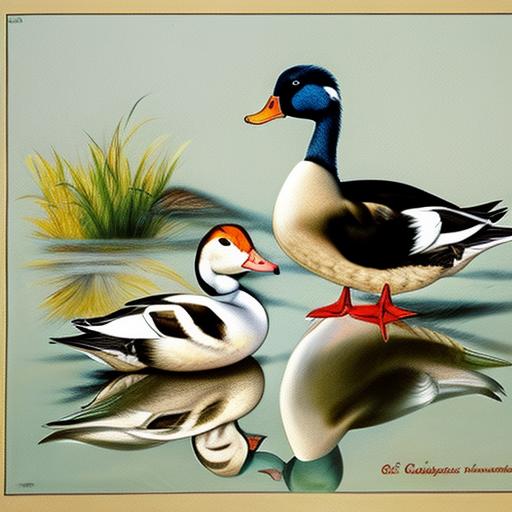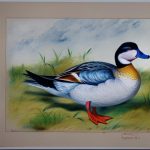Domestic duck breeds have been a part of human civilization for thousands of years. Ducks were first domesticated in East Asia, and over time, different breeds have been developed for various purposes, including meat, eggs, and ornamental purposes. Today, domestic duck breeds are popular among farmers, homesteaders, and hobbyists for their versatility, hardiness, and charming personalities.
There are numerous domestic duck breeds, each with its own unique characteristics and traits. Some breeds are known for their prolific egg-laying abilities, while others are prized for their flavorful meat. Additionally, there are breeds that are valued for their striking plumage and ornamental appeal. Whether you’re looking to raise ducks for eggs, meat, or simply as pets, there is a domestic duck breed that will suit your needs. In this article, we will explore the most popular and rare domestic duck breeds, their characteristics, and how to choose the right breed for your specific requirements.
Key Takeaways
- Domestic duck breeds come in a variety of sizes, colors, and purposes, making them a popular choice for backyard poultry enthusiasts.
- Popular domestic duck breeds include the Pekin, Khaki Campbell, and Indian Runner, known for their egg-laying abilities and friendly dispositions.
- Rare domestic duck breeds such as the Silver Appleyard and Saxony are prized for their unique appearances and heritage conservation efforts.
- Domestic duck breeds exhibit a wide range of characteristics including foraging behavior, egg production, and adaptability to various climates.
- When choosing the right domestic duck breed, consider factors such as space availability, desired egg production, and temperament to meet your specific needs.
- Caring for domestic duck breeds involves providing proper housing, nutrition, and protection from predators to ensure their health and well-being.
- In conclusion, domestic duck breeds offer a diverse range of options for poultry enthusiasts, and further resources such as breed clubs and conservation organizations can provide valuable information and support.
Popular Domestic Duck Breeds
1. Pekin Duck: The Pekin duck is one of the most popular domestic duck breeds in the United States. Known for its large size, white plumage, and friendly disposition, Pekin ducks are primarily raised for meat production. They are fast-growing and have a high feed conversion ratio, making them an efficient choice for meat production. Pekin ducks are also good layers, producing around 200-250 eggs per year.
2. Khaki Campbell: The Khaki Campbell is a popular dual-purpose breed known for its excellent egg-laying abilities. These ducks are prolific layers, with some individuals laying up to 300 eggs per year. They have a khaki-colored plumage and are known for their calm and friendly nature. Khaki Campbells are a great choice for those looking to raise ducks for egg production.
Rare Domestic Duck Breeds
1. Silver Appleyard: The Silver Appleyard is a rare breed that is prized for its striking plumage and dual-purpose qualities. These ducks have a beautiful silver and white feather pattern and are known for their excellent egg-laying abilities as well as flavorful meat. The breed was developed in England in the 1930s by Reginald Appleyard and has since become a rare breed in need of conservation efforts.
2. Saxony: The Saxony duck is another rare breed that originated in Germany. Known for its stunning blue plumage and calm temperament, the Saxony is a dual-purpose breed valued for both meat and egg production. Saxony ducks are good layers, producing around 200-240 eggs per year, and they also have a well-developed breast for meat production. Due to their rarity, Saxony ducks are considered a valuable addition to any duck enthusiast’s flock.
Characteristics of Domestic Duck Breeds
Domestic duck breeds come in a wide variety of sizes, shapes, and colors, each with its own unique characteristics and traits. Some breeds are known for their excellent egg-laying abilities, while others are prized for their flavorful meat or ornamental appeal. When choosing a domestic duck breed, it’s important to consider factors such as size, temperament, egg-laying capabilities, and intended use.
In terms of size, domestic duck breeds can range from small bantam breeds to large heavy breeds. Bantam breeds are typically smaller in size and are often kept for ornamental purposes or as pets. Heavy breeds, on the other hand, are larger in size and are often raised for meat production. When it comes to temperament, some breeds are known for being calm and friendly, making them suitable for families with children or as pets. Other breeds may be more skittish or independent and are better suited for farm or homestead settings.
Egg-laying capabilities vary widely among domestic duck breeds. Some breeds are prolific layers, producing upwards of 200-300 eggs per year, while others may only lay a few dozen eggs annually. If you’re looking to raise ducks for egg production, it’s important to choose a breed known for its excellent egg-laying abilities. Finally, it’s essential to consider the intended use of the ducks when choosing a breed. Whether you’re raising ducks for meat, eggs, or simply as pets, there is a domestic duck breed that will suit your specific needs.
Choosing the Right Domestic Duck Breed for Your Needs
When choosing the right domestic duck breed for your needs, it’s essential to consider several factors to ensure that you select the breed that best suits your specific requirements. First and foremost, consider the purpose for which you intend to raise ducks. If you’re primarily interested in egg production, then selecting a breed known for its prolific egg-laying abilities, such as the Khaki Campbell or Runner duck, would be ideal. On the other hand, if you’re looking to raise ducks for meat production, then heavy breeds like the Pekin or Muscovy would be more suitable.
Another important factor to consider is the climate and environment in which you live. Some domestic duck breeds are better suited to cold climates, while others thrive in warmer environments. For example, the Indian Runner duck is known for its ability to adapt to various climates and is an excellent choice for those living in diverse weather conditions. Additionally, consider the space available for raising ducks. Some breeds require more space to roam and forage, while others can thrive in smaller enclosures.
It’s also crucial to consider the temperament of the breed when choosing the right domestic duck breed. If you have children or are looking for ducks that will be friendly and sociable, then selecting a breed known for its calm and docile nature would be ideal. Conversely, if you’re looking for ducks that are more independent and self-sufficient, then choosing a breed with those traits would be more suitable.
Caring for Domestic Duck Breeds

Caring for domestic duck breeds involves providing them with proper housing, nutrition, and healthcare to ensure their health and well-being. When it comes to housing, ducks require shelter that protects them from predators and the elements while providing adequate space to move around and access to water for swimming and bathing. Duck houses should be well-ventilated and provide nesting areas for egg-laying breeds.
Nutrition is also essential for caring for domestic duck breeds. Ducks require a balanced diet that includes commercial duck feed or a mix of grains and pellets specifically formulated for waterfowl. Additionally, ducks should have access to fresh water at all times for drinking and bathing. It’s important to monitor their food intake to prevent obesity or malnutrition.
Healthcare is another crucial aspect of caring for domestic duck breeds. Ducks should receive regular veterinary check-ups to monitor their overall health and address any potential issues promptly. Additionally, ducks should be vaccinated against common diseases and parasites to prevent illness and ensure their longevity.
Overall, caring for domestic duck breeds involves providing them with proper housing, nutrition, and healthcare to ensure their health and well-being. By considering their specific needs and providing them with the necessary care and attention, domestic duck breeds can thrive and provide years of enjoyment for their owners.
Conclusion and Further Resources
In conclusion, domestic duck breeds offer a wide range of options for farmers, homesteaders, and hobbyists looking to raise ducks for meat, eggs, or ornamental purposes. With numerous popular and rare breeds available, there is a domestic duck breed that will suit any specific requirements. By considering factors such as size, temperament, egg-laying capabilities, intended use, climate, and space available when choosing a breed, individuals can select the right domestic duck breed for their needs.
Caring for domestic duck breeds involves providing them with proper housing, nutrition, and healthcare to ensure their health and well-being. By providing them with adequate shelter, a balanced diet, access to fresh water, regular veterinary check-ups, and vaccinations against common diseases and parasites, domestic duck breeds can thrive and provide years of enjoyment for their owners.
For those interested in learning more about domestic duck breeds or seeking further resources on raising ducks, there are numerous books, online forums, and local agricultural extension offices that can provide valuable information and support. Whether you’re a beginner or experienced duck enthusiast, there is always more to learn about the fascinating world of domestic duck breeds.
If you’re interested in learning more about domestic duck breeds, you might also want to check out Poultry Wizard’s article on “How Many Chickens Do You Need for a Family of 4?” This insightful piece provides valuable information on determining the ideal number of chickens for a family, which can be helpful for those considering raising ducks as well. (source)
FAQs
What are domestic duck breeds?
Domestic duck breeds are breeds of ducks that have been selectively bred by humans for specific traits such as egg production, meat quality, or ornamental purposes.
How many domestic duck breeds are there?
There are over 40 recognized domestic duck breeds, each with its own unique characteristics and traits.
What are some common domestic duck breeds?
Some common domestic duck breeds include the Pekin, Mallard, Rouen, Khaki Campbell, and Muscovy.
What are the differences between domestic duck breeds?
Domestic duck breeds vary in size, color, plumage patterns, egg production, and temperament. Some breeds are better suited for egg production, while others are raised primarily for meat.
Are domestic duck breeds good for backyard farming?
Yes, many domestic duck breeds are well-suited for backyard farming. They are relatively easy to care for, provide eggs and meat, and can also help control pests in the garden.
Do domestic duck breeds require special care?
Domestic duck breeds require access to water for swimming and bathing, as well as a balanced diet of duck feed, greens, and occasional treats. They also need protection from predators and shelter from extreme weather conditions.
Meet Walter, the feathered-friend fanatic of Florida! Nestled in the sunshine state, Walter struts through life with his feathered companions, clucking his way to happiness. With a coop that’s fancier than a five-star hotel, he’s the Don Juan of the chicken world. When he’s not teaching his hens to do the cha-cha, you’ll find him in a heated debate with his prized rooster, Sir Clucks-a-Lot. Walter’s poultry passion is no yolk; he’s the sunny-side-up guy you never knew you needed in your flock of friends!







